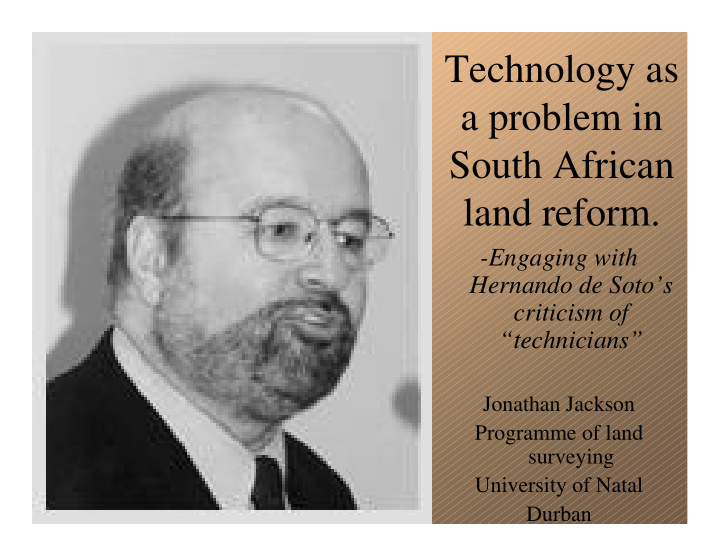



Technology as a problem in South African land reform. -Engaging with Hernando de Soto’s criticism of “technicians” Jonathan Jackson Programme of land surveying University of Natal Durban
Background on Hernando de Soto: • Peruvian economist, President of research think-tank Instituto Libertad y Democracia in Lima. • Author of popular books acclaimed by economists and (main stream) politicians:: – 1989: The Other Path: The invisible revolution in the Third World – 2000: The Mystery of Capital: Why Capitalism triumphs in the West and fails everywhere else .
De Soto’s argument: • Capitalism has failed outside of USA, Europe and some Asian countries. • Because Third World has not evolved systems of accessible fair law for all. • Formal property title underpins accumulation of capital in the West. • These property titles were evolved out of customary practices, many of them illegal at the time.
De Soto insists the titling system must adopt customary practices. • Quotes German saying “ The law must come from the mouth of the people” • Compare to Lao Tsu : The people must say “We are as we are of ourselves” ( Tao Te Ching) –i.e. good administration should be invisible to the people: it provides the matrix the people build with.
De Soto’s accusation against custodians of the property titling system: • Lawyers and “Technicians” obstruct progress. • “Technicians”: – In aid situations, apply domestic methods that ignore local customary practices. – Construct mere inventories that “say nothing about who really owns those assets or how people have organized the rights that govern them”( p215)
Suppose de Soto is right, what can technologists do? • Method 1: Stop acting from this limited technical perspective: – e.g. become more like sociologists – Work in collaborative partnerships with social scientists. • Method 2: My thesis: Find out what we are doing that is technically wrong. -Are spatial technologists like engineers who build cars with square wheels?
The case that failure of technologists has a technical solution: • In the colonial era, technology of the titling system certainly worked for the colonists. – Therefore technology itself is not inherently incapable. • If particular technical methods are in fact important, it is up to technologists to find these out. -No-one else will.
Five technical suggestions, based on acceptance of De Soto’s criticism: • Use a dumbbell information structure. • Employ a map-less interface at community level. • Place the office in the field. • Use an authentic register • Map the site of agreements instead of boundaries.
Technical suggestion (1): A “Dumbbell” information structure: To learn and apply customary practices, we need someone totally immersed in community. To broker information at the admin/business level, we need an information specialist.
(2) Use a map-less interface at community level. • Maps are used to communicate information to people far away from the place. – Not much value to residents. • Maps are difficult to construct: – Distract attention of workers. • Maps are too big to be left in hands of residents. – They appear distantly or ephemerally.
How a map- less interface could work: • Software with stored spatial information in layers. • Each object associated with a statement. • The position of a right or agreement determines what documents are played out.
(3) Place the office in the field. • Ensures integrity in referencing deed to place. 21 st Century equipment: • Most convenient for client. •Scanner • Encourages visibility •Printer of system. •Palm with GPS • Right social message •Internet downloads
(4) Use an Authentic Register instead of Title Register… “The Dutch model for Authentic Registers is simple: government guarantees the creation and maintenance of data for use by many organisations. The data is regulated, certified as accurate and current, and the producer assumes all liability for its use by others”. (Kok and van Loenen) Government: • Regulates and creates data • Obliges others to use this data • Assumes liability for its use.
Applying authentic register to SA tenure reform: • In the SA formal system, the state does not “assume liability for its use by others”. This responsibility is carried by the individuals who sign documents. • Apart from that, the SA formal system is close to the Netherlands model. – e.g. Deeds are recognised by the courts, who will issue orders/judgments based on their information. An authentic register’s value lies in its being used.
The authentic register and reinterpretation of the tenure track : Title register is step-wise series of explicit up- grades. Title Registration may over-manage. Authentic register gradually accumulates authority.
(5) Map the site of agreements instead of boundaries. • Boundary topology is – difficult to define and manage: – draws worker’s attention away from cultural concerns, – makes him dependent on technical expertise. – Difficult to revise. – In any case, just supports the Deed document. Introduce boundary surveys only at freehold level.
Conclusion: What could technologists create by such steps? • A new profession of workers skilled in documentary management of customary practices. • A learning machine whereby our society discovers its own practices. • A unity between the poor and capital, instead of the current exploitative informational chaos. • A rejuvenation of the cadastre.
Thank you jacksonj@nu.ac.za
Recommend
More recommend